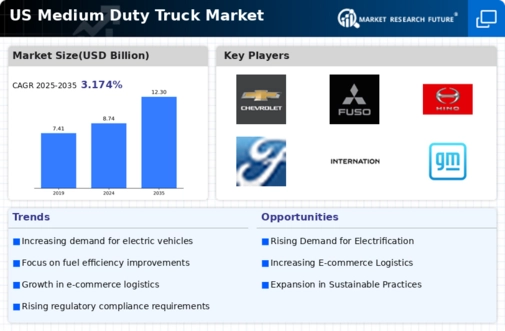Shifts in Consumer Preferences
Shifts in consumer preferences are significantly impacting the medium duty-truck market, as businesses adapt to changing demands for flexibility and customization. In 2025, it is estimated that around 25% of medium duty truck purchases will be influenced by consumer preferences for specific features, such as enhanced cargo capacity and advanced safety technologies. This trend indicates a move towards more tailored solutions that meet the unique needs of various industries, including construction, retail, and logistics. Manufacturers are responding by offering a wider range of configurations and options, thereby enhancing the attractiveness of medium duty trucks in a competitive market. As consumer preferences continue to evolve, the medium duty-truck market is poised for further transformation.
Rising Demand for Delivery Services
The medium duty-truck market experiences a notable surge in demand due to the increasing reliance on delivery services across various sectors. As businesses strive to meet consumer expectations for rapid delivery, the need for efficient transportation solutions becomes paramount. In 2025, the logistics sector is projected to account for approximately 15% of the total medium duty-truck market, reflecting a shift towards more agile supply chain operations. This trend is further fueled by the expansion of last-mile delivery services, which require versatile and reliable vehicles. Consequently, manufacturers are adapting their offerings to cater to this evolving landscape, enhancing the appeal of medium duty trucks for businesses seeking to optimize their delivery capabilities.
Infrastructure Development Initiatives
Infrastructure development initiatives in the United States play a crucial role in shaping the medium duty-truck market. The federal government has allocated substantial funding for the enhancement of transportation networks, including roads and bridges, which directly impacts the efficiency of medium duty trucks. In 2025, it is estimated that infrastructure investments will reach $200 billion, creating a favorable environment for the medium duty-truck market. Improved infrastructure not only facilitates smoother transportation but also reduces operational costs for businesses relying on these vehicles. As a result, the medium duty-truck market is likely to benefit from increased demand as companies seek to capitalize on enhanced logistics capabilities.
Sustainability and Environmental Regulations
The medium duty-truck market is increasingly influenced by sustainability and environmental regulations aimed at reducing emissions and promoting cleaner technologies. In 2025, regulatory frameworks are expected to tighten, with the U.S. government targeting a 30% reduction in greenhouse gas emissions from medium duty vehicles by 2030. This regulatory landscape compels manufacturers to innovate and invest in cleaner technologies, such as alternative fuels and electric drivetrains. As businesses seek compliance with these regulations, the demand for environmentally friendly medium duty trucks is anticipated to rise. This shift not only aligns with corporate sustainability goals but also enhances the market's appeal to environmentally conscious consumers.
Technological Integration in Fleet Management
Technological integration in fleet management systems is transforming the medium duty-truck market by enhancing operational efficiency and reducing costs. Advanced telematics and data analytics tools enable fleet operators to monitor vehicle performance, optimize routes, and manage maintenance schedules effectively. In 2025, it is projected that approximately 40% of medium duty trucks will be equipped with advanced telematics systems, reflecting a growing trend towards data-driven decision-making. This integration not only improves productivity but also contributes to lower fuel consumption and reduced emissions, aligning with broader sustainability goals. As businesses increasingly recognize the value of technology in fleet management, the medium duty-truck market is likely to witness sustained growth.



















Leave a Comment